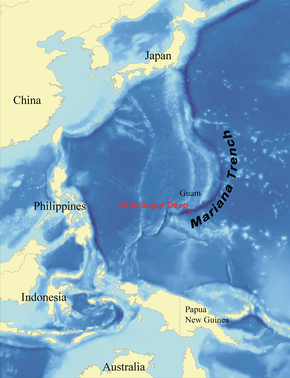China Breaks Records in Mariana Trench
Chinese scientists have broken two world records this year at the ocean's lowest depth - the Mariana Trench.
 The trench is about 2,550 kilometers (1,580 miles) long and around 69 kilometers (43 miles) wide. It reaches a maximum-known depth of 10,994 meters (36,070 feet) – which is more than Mount Everest at 8,850 meters.
The trench is about 2,550 kilometers (1,580 miles) long and around 69 kilometers (43 miles) wide. It reaches a maximum-known depth of 10,994 meters (36,070 feet) – which is more than Mount Everest at 8,850 meters.
China became the first country to collect the artificial seismic stratigraphy of the Challenger Deep, the deepest section of the trench, measured at a depth of more than 10 kilometers. The stratigraphy is used to study the continental plate movement and geological history.
The trench marks a subduction zone, where one piece of the Earth’s crust slides under another. In most other locations, these subduction zones involve a gradual downward slope, but in part of the Mariana Trench the Pacific Plate dives nearly vertically into the Earth.
China also set a new world diving record for underwater gliders at 6,329 meters (20,764 feet) with Hai Yi, a glider designed by the Chinese Academy of Sciences. The previous recorder holder was a U.S. glider at 6,000 meters.
The scientists also sampled snailfish in the Yap Trench at a depth of 7,884 meters (25,866 feet), a record depth for China for sampling fish.
Both experiments were carried out by Chinese scientists on board the academy's Explorer-I TS03 scientific surveying ship. The research team returned to China on Thursday.
In 2014, Hai Yi swam 1,022.5 kilometers nonstop in 30 days during a test, setting a record in China for the longest time and distance covered by an underwater glider.
The glider is an autonomous underwater vehicle designed to survey marine conditions, such as temperature, salinity, chlorophyll, oxygen and currents. It allows Chinese scientists to explore 97 percent of the oceans’ depths.
Different from other underwater vehicles, the glider does not have a propeller. Instead, there is an oil bag that works like fish bladder and a moveable battery. The glider also has a special hull made of light carbon fiber to protect it from the water pressure.
At the bottom of the trench the water column above exerts a pressure of 1,086 bars (15,750 psi), more than 1,000 times the standard atmospheric pressure at sea level. The temperature at the bottom is 1 to 4 °C (34 to 39 °F).
The trench is not the part of the seafloor closest to the center of the Earth. This is because the Earth is not a perfect sphere: its radius is about 25 kilometers (16 miles) less at the poles than at the equator. As a result, parts of the Arctic Ocean seabed are at least 13 kilometers (8.1 miles) closer to the Earth's center than the Challenger Deep seafloor.
Like other oceanic trenches, the Mariana Trench has, in the past, been proposed as a site for nuclear waste disposal in the hope that tectonic plate subduction might eventually push the nuclear waste deep into the Earth's mantle. However, ocean dumping of nuclear waste is prohibited by international law, and subduction zones are associated with earthquakes, making the results of such a move unpredictable.
